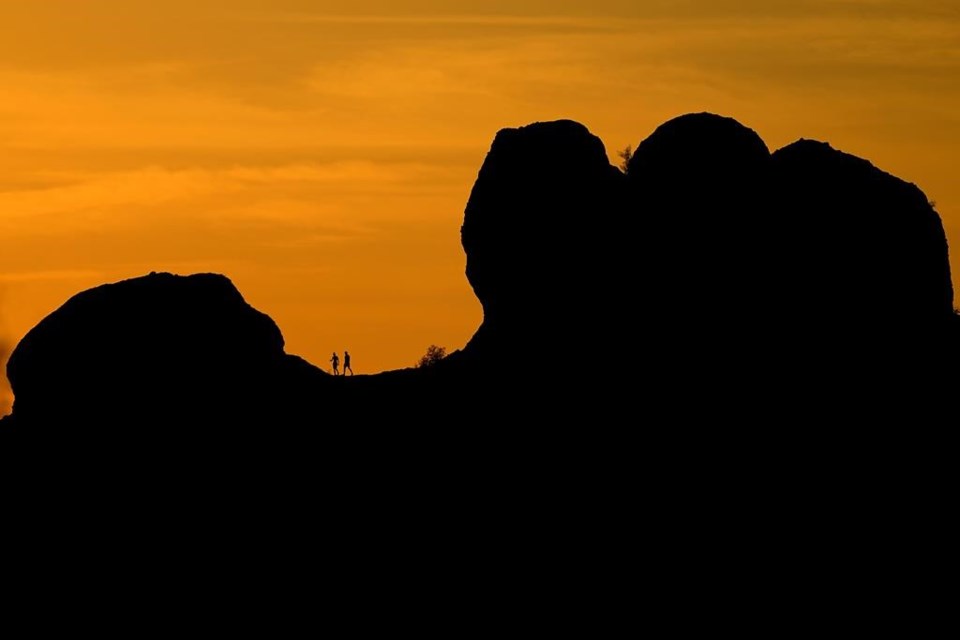PHOENIX (AP) — Heat never scared me before.
I’ve spent 23 years covering Phoenix as a photographer for The Associated Press, shooting golf tournaments, baseball games and other outdoor sporting events, the city’s growing homeless population, immigration and crime.
And, of course, heat.
Like most people around here, I talk about temperatures being in the teens as if it's a given that people know to always put a one in front of that number.
But this summer's record-shattering heat wave has been like no other.
No amount of water or Gatorade can keep you going in these conditions without adequate cool-downs throughout the day.
My phone and cameras continually glitch out and stop working. Even my car's air conditioning has struggled to keep up.
In my car, I keep a thermometer that I once used to check the temperature of chemicals in a darkroom. The heat inside when the air conditioner is off is way hotter than the air outside, and the thermometer often goes up to 125 degrees Fahrenheit (51.6 degrees Celsius).
In recent days it blew past that, with the needle registering well beyond where the numbers stop.
On the morning of July 10, I spent more than three hours off and on photographing life outdoors. Heat features are tough in part because people aren't stupid enough to be outside, unlike photojournalists.
When I got home, I was exhausted. But I got up the next day and went back out for another consecutive day of temperatures above 110 Fahrenheit (43.3 Celsius).
At one point my camera stopped working, and I had to cool it down in the car. It burned my hand to hold onto it.
On July 12, I covered a cooling shelter for homeless people and photographed a man at his tent in The Zone, an area of downtown blocks dotted by tents. The black asphalt streets were radiating heat.
I was sweating so profusely it dripped off me like a basketball player in an intense game. It was disgusting. It wasn't the first time this has happened and it's why I often carry a towel to dry off and keep the sweat from dripping in my viewfinder.
But then I realized there was no need to wipe down. I was dry. I stopped sweating altogether. My body had no more water to give. My legs started feeling chilled, an odd sensation. Then they cramped. It was obvious I needed to get out of the heat.
But I didn't think any more of it. That night I slept fitfully as temperatures remained high, and I had a headache.
By Friday, July 14, I was super lethargic and just wanted the work week to end. I was done with covering heat.
On Saturday I rested and thought, “I'm in Arizona. It is what it is.”
After the weekend, I had a dermatology appointment on Tuesday to remove a spot of basal cell carcinoma, the most common form of skin cancer. Such procedures have become almost routine after so many years working in Arizona.
That day Phoenix broke its record for the longest streak above 110 Fahrenheit (43.3 Celsius), marking the 19th day with such heat.
When I got checked, they told me I was a mess. My blood pressure was clocked at 178/120. After telling me that, it shot up to 200/120. The nurse wanted to send me in an ambulance to the emergency room because they thought I was going to have a heart attack.
It's so surprising it seems funny now. I assumed I was just tired from work.
I opted to see my doctor on Wednesday and was told I was suffering from heat exhaustion.
I had precautionary blood work done the next day to make sure all is normal. But not without first experiencing more heat-related fallout: they couldn’t draw blood from either arm because I was still slightly dehydrated. Unfortunately that meant they took it through my hands, which wasn’t pleasant.
The great news is, I’m fine. I spent two days inside and my blood pressure Friday was down to 128/72.
I will be more cautious going forward until this heat wave passes and have developed a plan with my fellow photographer, Ross Franklin.
In extreme heat, we will limit ourselves to 30– to 40-minute windows of shooting before breaking to cool down. We're keeping chilled, damp towels in a cooler in our cars and about two to three times as much water and Gatorade as we would have normally.
A separate cooler with plastic ice packs holds our cameras when we're not shooting. We have extra dry towels for sweat. We also plan to send all our images from inside a cooled building, not from our cars as we usually do.
And if we really feel bad, we promise to simply call it quits. No exceptions.
We typically fight through not feeling well on assignments — but not with heat.
It's too risky.
Matt York, The Associated Press



